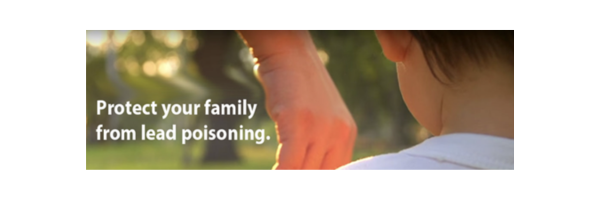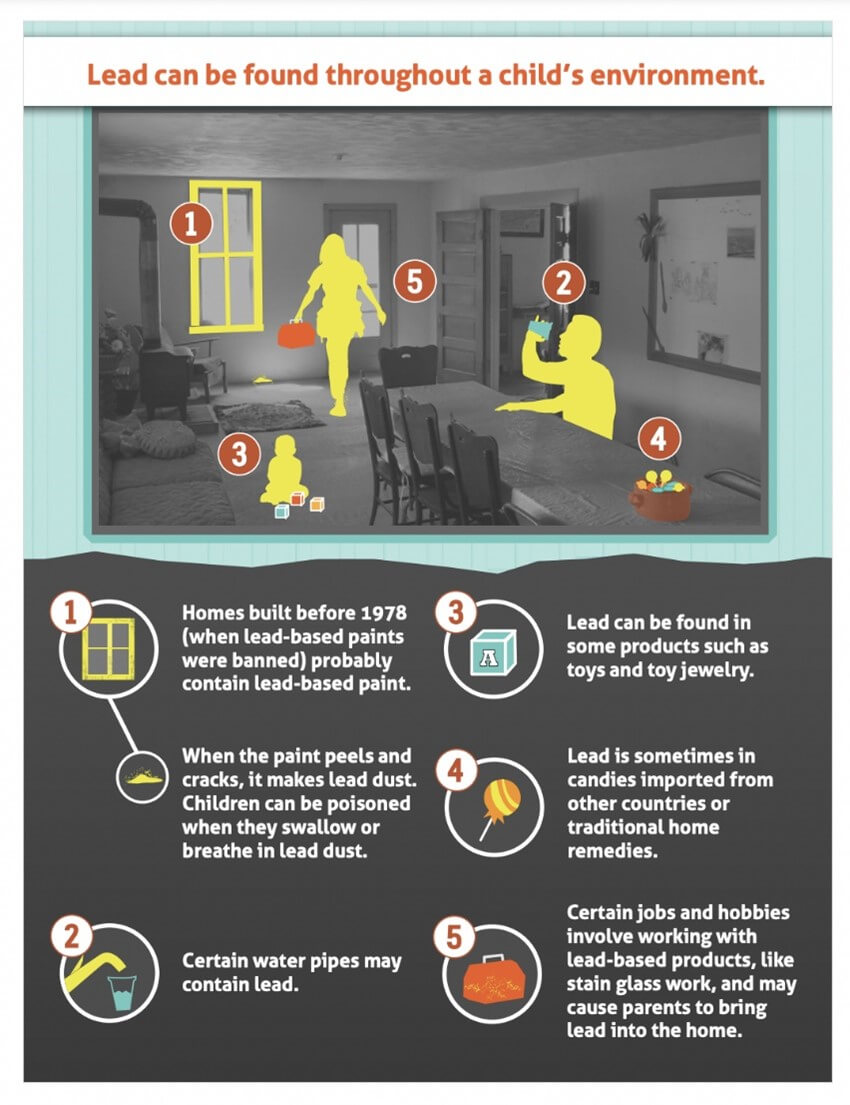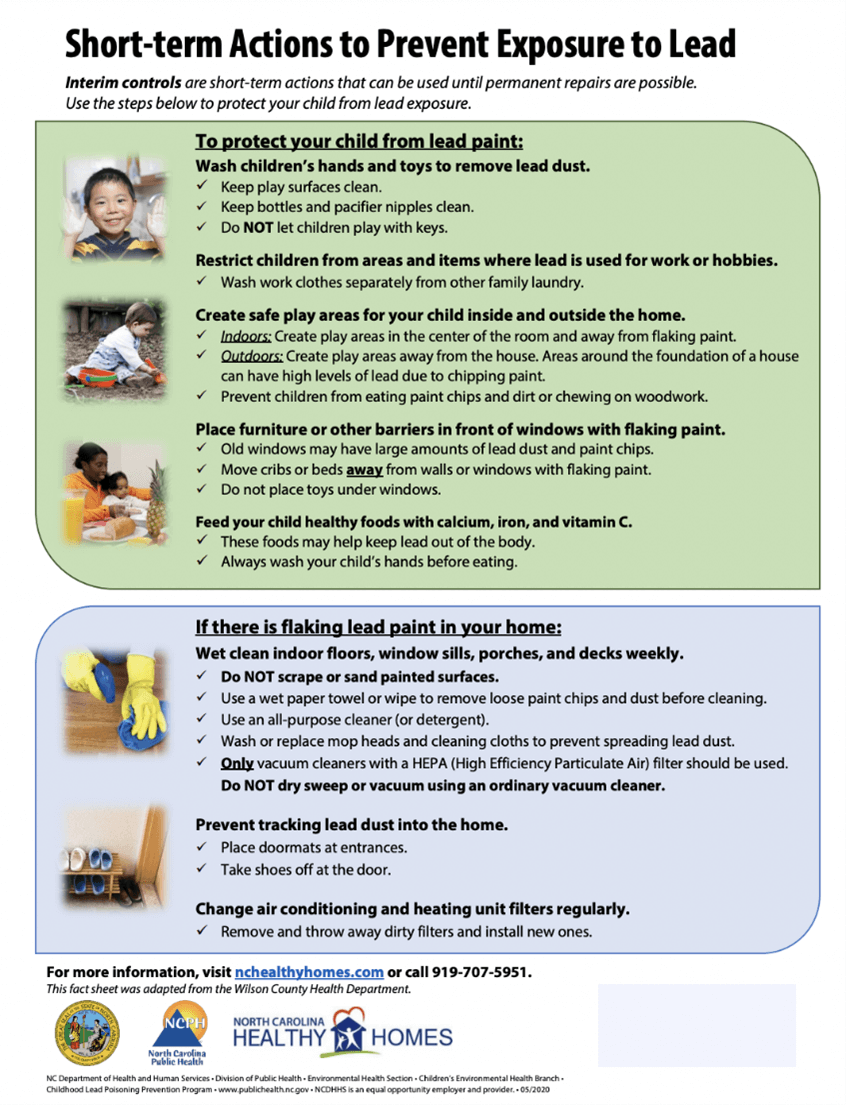Lead Poisoning

Learn More
For more information about the ongoing City of Durham soil assessment at Durham parks, visit the Durham Parks and Recreation website.
What is lead?
Lead is a naturally occurring element that can have negative health effects on people and animals. Lead poisoning remains a major environmental hazard facing children in the United States. Currently, at least four million households have children that are being exposed to high levels of lead.
There is no "safe" level of lead exposure. Lead exposure can affect nearly every system in the body. Lead poisoning is preventable, yet the negative health effects can be life-long if it is not treated early. Lead exposure is dangerous to children and adults of all ages, and the effects are most harmful to children under age six because lead can be easily absorbed into their growing bodies.
Video: What to know about lead safety
How can I get my child tested for lead?
For lead screening events at childcare centers, elementary schools, and other community centers within Durham: Contact Lakieta Sanders at 919-560-7842 or email ldsanders@dconc.gov to request testing and determine availability.
For individual blood lead testing: contact your primary care provider to request testing. If you do not have a primary care provider, contact Lincoln Community Health Center.
How can I get my home tested for lead?
For home lead testing (homes built before 1978, the year lead-based paints were banned): Find a North Carolina Certified Lead Professional here.
What are common sources of lead exposure?

Common sources of lead exposure include:
- Homes built before 1978 (the year lead-based paints were banned). Homes built before this year probably contain lead-based paint. When the paint peels and cracks, it makes lead dust. Children can be exposed to lead when they swallow or breathe in lead dust.
- Certain water pipes.
- Some products such as toys and jewelry.
- Some candies, traditional home remedies, and spices.
- Parents in certain jobs and hobbies that involve working with lead-based products, like stain glass work
- Air and soil near airports from aviation gas used in piston engine aircrafts
- Other contaminated soil
(Source: CDC)
How can you prevent lead exposure?
Find ways to prevent lead exposure below. This is not a complete list of all ways to prevent lead exposure. Find more prevention tips on the EPA's website here or the CDC's website here.

Prevent lead exposure at home, if your home was built before 1978 (the year lead paint was banned):
- Consult a certified lead professional to learn how to have your home's paint and dust tested for lead
- Make sure your child does not have access to peeling paint or chewable surfaces painted with lead-based paint.
- Consult a certified lead professional before beginning renovation, repair or painting projects. Renovation, repair or painting activities can create toxic lead dust when painted surfaces are disturbed or demolished. Learn more about lead-safe contractors.
Preventing lead exposure from drinking water:
- Contact your water utility to have your water tested and to learn more about the lead levels in your drinking water.
- Drink, cook, and mix baby formula only with water that comes out of the tap cold. Water that comes out of the tap warm or hot can have higher levels of lead. Remember, boiling water does not remove lead from water.
- If you use a filter, make sure you use a filter certified to remove lead. Read the directions to learn how to properly install and use your cartridge and when to replace it.
Preventing lead exposure from soil:
- Prevent children from playing in bare soil. If possible, provide them with sandboxes. Cover sandboxes when not in use to prevent cats from using them as a litter box.
- Take off shoes when entering the house to prevent bringing lead-contaminated soil in from outside.
- Wash hands several times a day using soap and water, especially after playing or working outside.
- Do not grow fruits or vegetables in lead-contaminated soil. Using a container garden is a good alternative.
Preventing lead exposure from toys and products:
- Do not let children play with recalled toys, toys manufactured before 1978, and vintage and antique products. Older toys and other products may contain lead-based paint. Get information on recalls from the Consumer Products Safety Commission website.
- You can test products for lead by submitting a sample to a certified laboratory. Only a certified laboratory can accurately test products for lead content. Although do-it-yourself kits are available, they do not show how much lead is present and may not be reliable.
What are the health risks of lead exposure?
Exposure in children less than 6 years old:
Exposure to lead causes negative effects such as:
- Damage to the brain and nervous system
- Slowed growth and development
- Learning and behavior problems
- Hearing and speech problems
This can cause:
- Lower IQ
- Decreased ability to pay attention
- Underperformance in school
There is also evidence that childhood exposure to lead can cause long-term harm.
Learn more about lead exposure in children here.
Exposure in people who are pregnant:
Lead exposure during pregnancy can cause harmful effects including:
- Increase risk for miscarriage
- Cause the baby to be born too early or too small
- Hurt the baby’s brain, kidneys, and nervous system
- Cause the child to have learning or behavior problems
Learn more about lead exposure during pregnancy here.
Resources
Learn more about lead exposure and how to protect your family.
- Lead Safety Overview (English | Spanish)
- Protect Your Family from Lead in Your Home (English | Spanish)
- Know the Facts: Protect Your Child from Lead Exposure (English | Spanish)
- Short-Term Actions to Prevent Exposure to Lead (English | Spanish)
- 5 Things You Can Do to Lower Your Child's Lead Level (English | Spanish)
- Sources of Lead in Drinking Water (English | Spanish)
- Preventing Take-Home Lead Exposure (English | Spanish)
- Cleaning up Lead Dust in Your Home and Car (English | Spanish)


